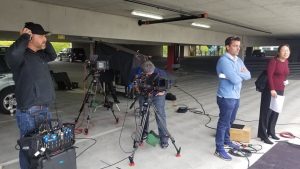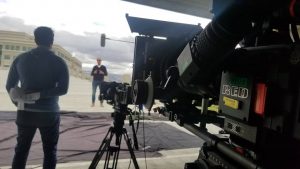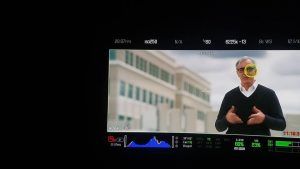Since I started as a location sound engineer 15 years ago, many things have changed: SD beta changed to HD, labeling tapes to labeling wav files, striping bars and tone to making sure I have the latest timecode cable for the latest Red Camera. But the most pervasive change is this: it is assumed that the sound recordist will always hide the lav mics on any subject.
 This became clear to me the other day when one of the techs came back from a shoot and was told NOT to hide the mics for a more newsy look. This is a stark change from where things began, where producers would have to ask apologetically to the sound people to hide the mic “if they could”. Those days are gone. Modern video production assumes that the sound mixer will be able to record a clean dialogue track from a hidden mic on any wardrobe choice.
This became clear to me the other day when one of the techs came back from a shoot and was told NOT to hide the mics for a more newsy look. This is a stark change from where things began, where producers would have to ask apologetically to the sound people to hide the mic “if they could”. Those days are gone. Modern video production assumes that the sound mixer will be able to record a clean dialogue track from a hidden mic on any wardrobe choice.
 This new reality was on full display on a shoot I recently did for Cisco where they were shooting 8k on red dragons. Given that the resolution is now so high, many productions have started shooting insanely wide for the flexibility in post to push in and frame the shot how they see fit in the comfort of their edit suites. This was what the Cisco producers planed to do with the footage and we had to deal with things accordingly.
This new reality was on full display on a shoot I recently did for Cisco where they were shooting 8k on red dragons. Given that the resolution is now so high, many productions have started shooting insanely wide for the flexibility in post to push in and frame the shot how they see fit in the comfort of their edit suites. This was what the Cisco producers planed to do with the footage and we had to deal with things accordingly.
As I was setting up, one of the older producers asked, “aren’t you going to set up a boom for backup?” I answered no. I told him we were about 4 feet from the interviewees head and that the boom would be good for nothing other than making us both feel better. I have found in these situations to reach for the boom as a backup, but feel it only distracts from the one true objective: making sure I have a perfectly placed hidden lav that sounds great. Checking in on a boom that no one is going to use only serves to distract my ears, and give false hope to a do or die situation.

What’s the point? All Nomad Audio engineers are able to hide mics on interviewees and make them sound great. Our extensive experience in reality style shooting has taught us a lot about making this work. In many of the outdoor shoots we’ve done, one not only has to plant a clean sounding mic, but also needs to make sure it’s windproof and that the transmitter is waterproof. Working at the higher level lets us succeed where other engineers wouldn’t and is a big part of what sets us apart and makes our productions sound great!
 Nomad Audio | Audio Post Production and Location Sound in the San Francisco Bay Area
Nomad Audio | Audio Post Production and Location Sound in the San Francisco Bay Area